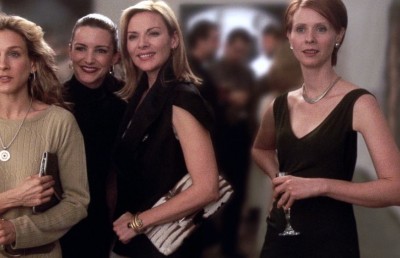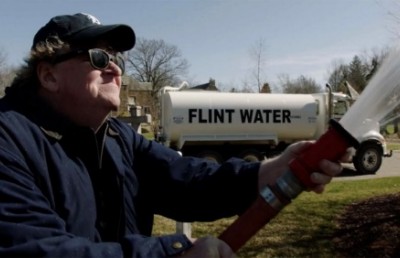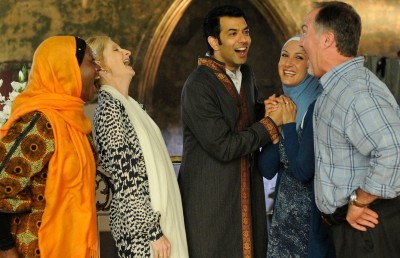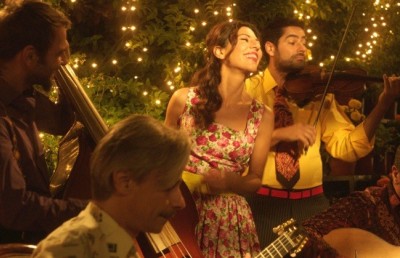Fate Hate
Quentin Tarantino and Reel Politics
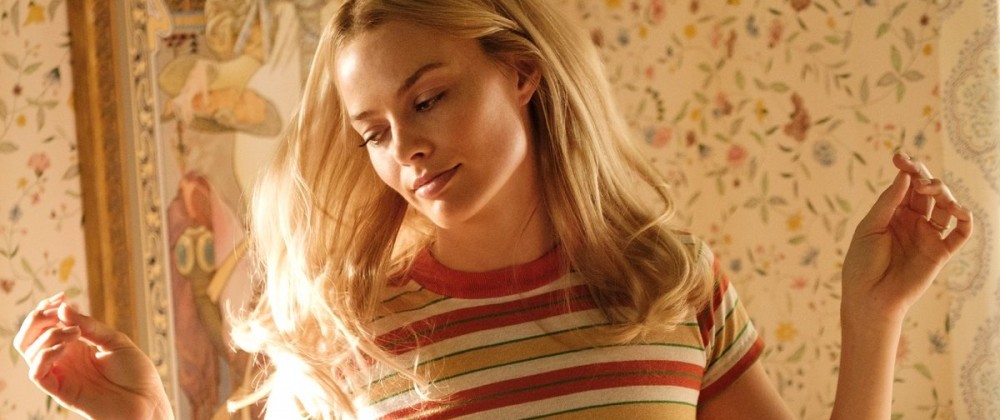
Amidst the second season of David Lynch and Mark Frost’s TV series Twin Peaks, the millionaire hotelier and businessman Ben Horne’s character suffers a mental breakdown in which he regresses into an imaginary time during the US Civil War. To the initial dismay of his daughter, Audrey, Horne styles himself as a Confederate general, fighting off and eventually defeating the northern forces. Dr. Jacoby, the town’s psychiatrist, explains that Horne must symbolically reverse the south’s defeat in order to psychologically conquer his own setbacks.
In the final scenes of Stanley Kubrick’s The Shining, Danny Torrance’s character evades a terrible wintry fate by retracing his footprints in the snowy maze of the Overlook Hotel, mystifying and finally freezing his ax-wielding father in close pursuit.
In the second instalment of the Back to the Future film franchise, the evil Biff Tannen’s character hijacks Doc Brown’s time machine DeLorean, creating an alternate dystopian future in which Tannen rises to a vulgar kind of fortune and fame. Marty and Doc manage to travel still further back into the past to thwart Tannen and fix this broken future.
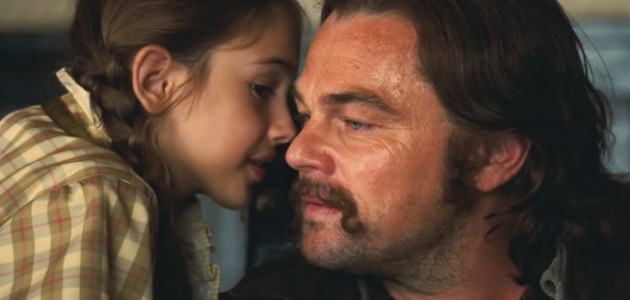
Accompanying Donald Trump’s political ascent in the US, a memeplex materialised online around Trump and Tannen’s similarities. Back to the Future writer Bob Gale conceded a 2015 interview that Trump was indeed Tannen’s inspiration — a loathsome megalomaniac who nonetheless cast himself as a nationalist folk hero.
In all of these fictional narratives, the protagonists metaphorically and literally rewind and repair their fatal faults. As much as some of us may wish, though, we in 2020 are not able to return to a pivotal moment and undo Donald Trump’s presidential election. And so, it seems that we are condemned to sit on our hands and live through this uncouth and less-than-ideal timeline.
Quentin Tarantino appears to share this sense of frustration with our current destiny. His latest film, a meticulous period-piece, in addition to an exemplary specimen of virtuoso filmmaking, nearly wilfully refuses to acknowledge the present, and furthermore readjusts the past in the spirit of Ben Horne, Danny, Doc and Marty.
Tarantino’s most recent works have been consumed thematically with a righteous setting straight of history, what Rolling Stone movie critic David Fear “called Tarantino’s “cinematic corrective”: Inglourious Basterds awards retribution against Nazi Germany in World War II to a squad of Jewish American soldiers; Django: Unchained represents Black American characters furiously punishing US slavery’s perpetrators. Once Upon a Time … in Hollywood likewise steps in to defend history’s victims — this time, the screen star Sharon Tate and others famously murdered by the Manson family in August 1969.
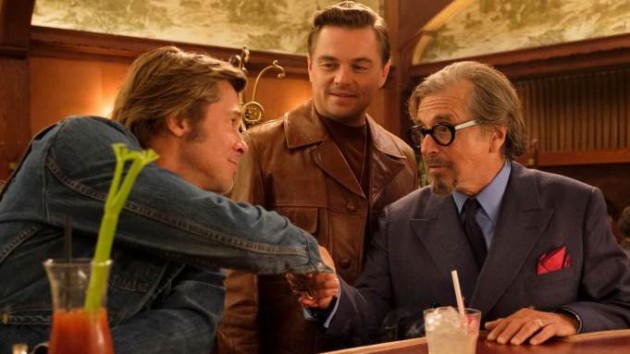
Once Upon a Time … in Hollywood tells the fictional buddy fairy tale of Rick Dalton (Leonardo DiCaprio), a veteran actor in film and TV westerns, and his rugged and dependable stunt double and best friend, Cliff Booth (Brad Pitt). Dalton and Booth increasingly struggle to find work, and meaning, in a rapidly shifting moving picture industry. Running parallel to Dalton and Booth’s travails, Tarantino tees up the real-life character of Sharon Tate (Margot Robbie) and the Manson family murders as the film’s historical fairway. Once Upon a Time … in Hollywood is a nostalgic snapshot of Tarantino’s favourite time and place — 1960s Hollywood — and also a saga that takes pleasure in faithfully recounting and creatively revising real history simultaneously.
One can revel in Once Upon a Time … in Hollywood in any number of ways. Cineastes can delight in identifying every little reference Tarantino makes to every authentic piece of film history, and there are many. Dalton and Booth are stained-glass mosaics fashioned from shards of the patron saints in Tarantino’s classical-era cathedral. The director spends almost three hours — equivalent to the film’s epic length — in an interview with his Los Angeles theatre The New Beverly’s podcast the corresponding movies, series, actors, directors, agents, trailers, posters, and assorted film folklore which influenced him. Film technicians, too, will thrill in seeing the behind-the-scenes production process so painstakingly depicted.
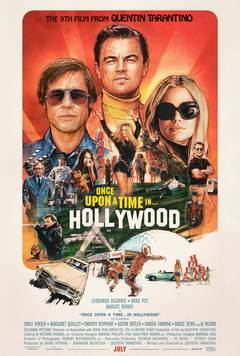
Then there is the music. Tarantino is nearly as fanatic as he is about film in assembling the ideal mixtape to soundtrack his version of 1969 Hollywood, tracking down the kinds of records that Sharon Tate might have Watusi’d to, and the sorts of songs, jingles, commercials, contests, and station ephemera that would have played concurrently on LA radio. Enthusiasts of Manson’s recordings can feel an uncanny twinge of recognition as the group of girls during their introductory dumpster-diving scene sing the childlike “I’ll Never Say Never to Always”, a composition that appears on Manson’s 1970 album, LIE: The Love and Terror Cult.
Smokers can smirk at the ever-presence of cigarettes in the frame. Petrol-heads can drool over Tate’s Porsche, Sebring’s Firebird, Polanski’s MG, Dalton’s bitchin’ Coupe de Ville. Urban historians can get a kick out of the era-appropriate Los Angeles theatre marquees, façades, bus stops, storefronts, and street signs. Product design aficionados can marvel at the proper flasks, casks, bottles, cans, labels, and containers for bygone consumer goods that were once ubiquitous on supermarket shelves. Retro technology fetishists can chuckle at Dalton’s reel-to-reel cassette recorder, and stacks of cathode-ray television sets. There is a montage designed just for antique neon sign lovers. Oftentimes, period-specific movies can seem too contrived, their props and sets too sanitary; but even clouds of dust get their dramatic due here — once when Rick flings his child co-star to the floor while improvising a scene; again, when he throws a tantrum in his trailer over flubbed lines.
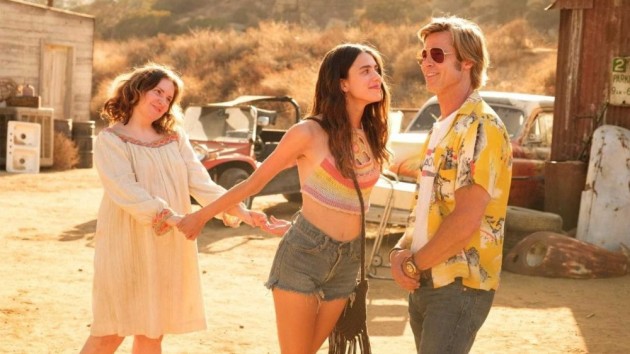
Tarantino curates a veritable garage sale gallery show of 1969 kitsch Americana, and the film appeals particularly to the postmodern pastiche mentality of the obsessive popular culture completist. Clustered together, all of these things make us believe in Dalton and Booth’s story, or that Rick and Cliff are fictitious characters that plausibly could have existed at that storied time in Southern California. What is most instructive, though, is how Tarantino breaks with history — namely, his revisionist resolution of the parallel Manson-family subplot.
Tarantino ostensibly chooses the Manson family as his revenge object in much the same way that he did previously with Nazis and slave owners. Imagining hypothetical violence upon those who inflicted real violence makes Tarantino’s brand of gratuitous violence palatable, cathartic — as satisfying as seeing the Sunday matinée villain get his comeuppance. It is a clever loophole that Tarantino has tied open to evade his detractors’ preferred criticism: even those opposed to onscreen violence in general cannot argue against punishing Nazis, slavers, or the Manson clan.
Still, if films are like a filmmaker’s dreams — onscreen projections of subconscious fears, desires, wish-fulfillment, symbolic ideation — then we must tease out and interpret the object, because the superficial object is never the true object. We have to dig deeper. Tarantino’s revisionist revenge fantasy is not about (at least not solely about) cinematically correcting the Manson family murders, or the death of the 1960s, or the demise of Tarantino’s golden age of the American film and TV industries, or the end of Hollywood’s classical era innocence. It is also about Tarantino’s — and our own — fear of fate, and the rejection of the most unpleasant of present realities. Tarantino concocts illusory horrors that we are compelled to enjoy and applaud in order to uphold our conscious condemnation of the real-life horrors we find abhorrent.
Once Upon a Time … in Hollywood represses three recent collective cultural traumas:
First is the #MeToo movement that gained momentum after The New York Times and The New Yorker exposed a pattern of criminal sexual harassment by Harvey Weinstein, Tarantino’s long-time benefactor. The scandal reached Tarantino, who was implicated as exploitative and reckless in his filmmaking. Uma Thurman in 2018 asserted an injury she had suffered while shooting Kill Bill was in large part Tarantino’s liability. Feminist critics frequently fault his films for alternately objectifying, abusing, and suppressing women. Two Time magazine contributors statistically the female-to-male ratio of dialogue across Tarantino’s oeuvre, concluding that even his works that feature female leads reflect a script-based gender imbalance.
Whether or not this is proof of Tarantino’s misogyny is up for discussion. What is clear, though, in Once Upon a Time … in Hollywood is that the director does not shy away from training the camera on the female form. A number of tracking shots that follow Margot Robbie’s Sharon Tate are filmed at hip level. In a scene where Booth stops to pick up a hitchhiking member of the Manson family (a conjectural character called Pussycat), Margaret Qualley’s posterior conspicuously consumes the frame. Again, these elements do not necessarily condemn Tarantino as a chauvinist. He merely directs his audience’s gaze. One could claim that Brad Pitt’s Cliff is equally sexualised when he removes his shirt while fixing Rick’s broken antenna.
What Tarantino wants to construct is an amended history in which beautiful women, men, and children could have existed onscreen, as well as in the real-world 1960s Hollywood milieu, without being objectified or exploited. When Pussycat offers Booth sexual favours in exchange for a ride to the Spahn Ranch, Booth refuses. Elsewhere in the film, Dalton enacts a scene in a western with eight-year-old Trudi, played by Julia Butters. It is shocking when he hurtles the child to the dirty floor. But DiCaprio’s Rick ensures that Trudi endured uninjured by the performance. The film offers its principle male characters ample opportunity to behave badly with women and girls. However, in Tarantino’s version of Hollywood history, they uprightly opt not to.
The second repression is perhaps more tenuous and obscure. But there is arguably a denial of the September 11th attacks that symbolically emerges in Once Upon a Time … in Hollywood. Tarantino casts the Manson family as the real antagonists in his make-believe narrative because the Manson murders were the most confounding and terrifying events of their time. Those gruesome crimes traumatized America for the fifty years that followed. They went beyond senseless aggression; revolutionary ideology motivated them; they were not simple murders; they constituted an attack on the American way of life. 9/11 is this era’s most terrifying event. And from the first scene, Tarantino constructs Dalton and Booth as figurative twin towers.
They are not the film’s only twins, though. The doppelganger-double motif runs throughout. Roman Polanski is paired with Jay Sebring; Sharon Tate with Joanna Pettet; Trudi has her own stunt double; Manson has “Tex” Watson; and Manson and Tex are the shadowy underworld versions of Rick Dalton and Cliff Booth. Much like Osama bin Laden and the group of terrorists that perpetrated the twin tower attacks, the Manson clan target what they perceive as the most decadent aspects of American culture.
The film sacrifices Dalton and Booth in place of Tate and the others murdered by the Manson family. But Cliff and Rick fight back and prevail. As Sadie stabs Booth in the hip, echoes resound of that first American Airliner plunging into the World Trade Center’s north tower. But Booth remains standing, and Dalton ultimately gets vengeance with good old Yankee firepower. The film preserves the duo’s integrity at all costs, and thus preserves the integrity of the duo, more broadly speaking.
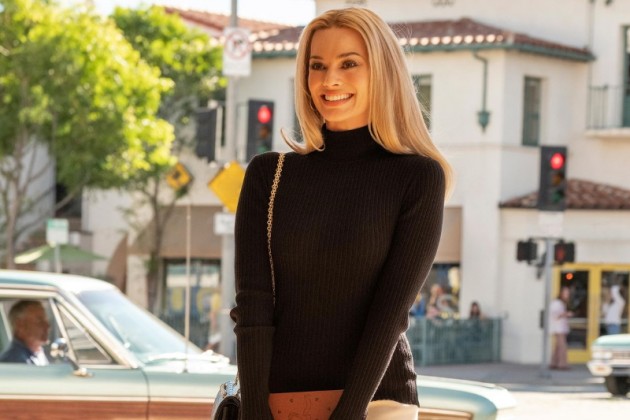
In redeeming Sharon Tate, Tarantino effects the film’s third repression — the denial of climate change and capitalism’s inherent violence. The director’s encyclopedic knowledge of Charles Manson-as-activist was evident more than two decades ago in his script for Oliver Stone’s 1994 film, Natural Born Killers. In that picture, Tarantino wrote a monologue for Woody Harrelson’s Micky Knox character that suffused Manson’s infamous interview with Geraldo Rivera with details from director Nikolas Schreck’s 1989 documentary, Charles Manson: Superstar. “It’s just murder,” Knox asserts: “All God’s creatures do it. You look in the forests and you see species killing other species, our species killing all species including the forests, and we just call it industry, not murder.”
In the real world as in the film, Manson’s personal involvement in the killings that bore his name are left ambiguous and subject to doubt. Subsequent to Manson’s conviction for conspiracy to commit murder, and throughout his lifelong incarceration, Manson fashioned himself as an environmental crusader and advocate of nature’s harmony, a movement that he termed “ATWA”, or Air, Trees, Water, Animals. Manson considered his prison life to be the mirror reflection of Richard Nixon’s corrupt and brutal administration. Twice in Once Upon a Time … in Hollywood, America’s involvement in the Vietnam war, as well as Hollywood’s worship of murder and mayhem, are offered up as motives for the family’s plan to kill “the pigs”. Doubtless, Tarantino was acutely aware of Manson’s radical philosophies, which manifest in Sadie’s monologue about killing the Hollywood actors who taught them to kill by celebrating slaughter onscreen.
Tarantino at once tacitly accepts culpability for his own role in rejoicing capitalism’s infatuation with death, and also rejects the premise that capital itself is responsible for violence. Dalton and Booth are able to unproblematically do several of the things that eventually condemn the Manson family characters. Cliff’s trailer home is portrayed as disheveled and dirty because he is a character of grit; the Spahn Ranch, however, is rendered in rat-infested squalor because it is inhabited by a group of filthy hippies. Booth can smoke an LSD-spiked cigarette, which only enhances his senses and sharpens his reflexes; but when the Manson girls speak of their acid trips, it serves to reinforce their lunacy. The film even absolves Booth of presumably murdering his wife. In Tarantino’s Hollywood — indeed, in Tarantino’s America — the dominant order remains intact, regardless of its misgivings. This is the director’s trouble-free fairy tale.
If Quentin Tarantino could turn back time and change our fate, if he could don a southern soldier’s uniform like Ben Horne, or retrace his snowy steps like Danny Torrance, or take Doc Brown’s DeLorean for a quick spin through recent history, Sharon Tate might still be alive today. Salt-of-the-earth actors like Rick Dalton, and their stalwart stunt doubles’ careers would never have dwindled. And Hollywood’s glitz and glamour would never have tarnished.
But also, Harvey Weinstein might never have abused innumerable women; the World Trade Center might still be standing; Donald Trump might not be America’s president; and the planet might not be spiralling evermore toward capitalist-driven environmental oblivion. At least, we could all smoke cigarettes carte blanche.


